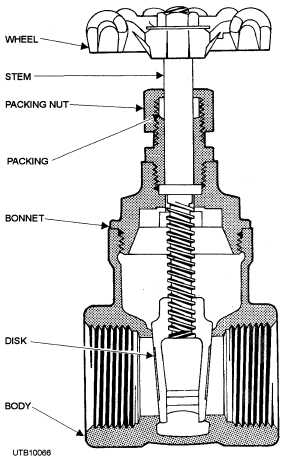CHAPTER 4 PLUMBING VALVES AND ACCESSORIES
LEARNING OBJECTIVE: Recognize types of valves, accessories and their use, methods of installation, maintenance, and repair.
In this chapter, you are provided information regarding types of valves and procedures for installing and repairing them, valve accessories, and pipe fittings. Also discussed are testing of systems, erecting shoring and scaffolding, and laying out wastewater systems, and water distribution systems.
VALVES
LEARNING OBJECTIVE: Recognize types of valves and methods of valve repair. Flexibility in the operation of a water-supply system requires the proper valves for the condition that is to be controlled. Valves are used to stop, throttle, or control the flow of water in a pipeline. Other uses include pressure and level control and proportioning flow. A number of different valve designs are used by a Utilitiesman. In this section, different types of valves, their purpose, and maintenance and repair of valves are presented.
GATE VALVE
The gate valve (fig. 4-1) is used in systems where a straight flow with the least amount of restriction is needed. These valves are used in steam lines, waterlines, fuel oil lines, and fire-main cutouts.
The part of a gate valve that opens or closes the valve flow is known as the GATE. The gate is normally wedge-shaped; however, some are uniform in thickness throughout. When the gate is wide open, the opening through the valve is equal to the size of the piping in which the valve is installed; therefore, there is little resistance in the flow of the liquid. Since regulating the flow of liquid is difficult and could cause extensive damage to the valve, the gate valve should NOT be used as a throttling valve. The gate valve should be left in one of two positions- completely open or closed.

Figure 4-1. - Gate valve.
Figure 4-1 shows a cross-sectional view of a gate valve. The gate is connected to the valve stem. Turning of the handwheel raises or lowers the valve gate. Some gate valves have NONRISING STEMS. On these, the stem is threaded on the lower end, and the gate is threaded on the inside; therefore, the gate travels up the stem when the valve is being opened. This type of valve usually has a pointer or a gauge to indicate whether the valve is in the OPEN or in the CLOSED position. Some gauge valves have RISING STEMS. In these valves, both the gate and the stem move
Continue Reading